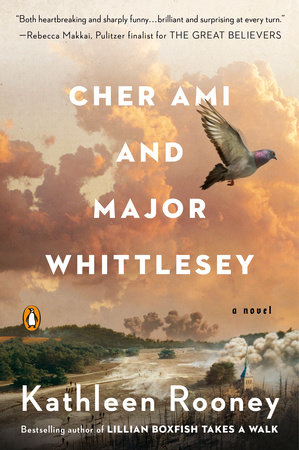Cher Ami and Major Whittlesey Reader’s Guide
By Kathleen Rooney


1. The book opens with two epigraphs: one from Aristotle and one from General Joseph Joffre. Why do you think the author chose these to precede the story? What themes do they set you up to expect?
2. Kathleen Rooney chooses to tell the story in the alternating voices of Cher Ami, a pigeon, and Charles Whittlesey, a human. How would the story be different if she had only offered one perspective? What do the two interwoven perspectives do for the impact of the overall narrative?
3. Do you consider yourself an animal lover? Does that love extend to pigeons? Did this book change the way you look at pigeons or other animals? If so, how?
4. Cher Ami speaks, from inside the Smithsonian, of “World War II, which happened even though the horrors of the Great War were said to have obviated all future war” (page 7). Did you know much about World War I, aka the Great War, prior to reading this book? If so, how did this book make you see it anew? If not, what shocked you in this book’s depiction of that conflict?
5. Compare the attitudes that the animals have regarding their role in the war to those attitudes held by the humans. How are they similar and how are they different?
6. When he’s an undergraduate at Williams College, Whit writes in his yearbook that the purpose of a college education is “learning to judge correctly, to think clearly, to see and to know the truth, and to attain the faculty of pure delight in the beautiful” (page 50). How do his youthful idealism and his excellent education prepare him—or not—for the horrors of trench warfare?
7. Both Cher Ami and Whit fall in love during their time on the front in France. How do their relationships to their beloveds—Baby Mine and Bill Cavanaugh, respectively—compare and contrast?
8. The media, including Damon Runyon and others, plays a complex role in this story in that it makes the men—and animals—of the Pocket so famous as to require them to be saved (when, under other circumstances, they would have been sacrificed), but it also paints a simplified and damaging picture of their heroism and what they endured. How should people on the home front think about the experience of soldiers at war, given that the information that they receive will always be suspect?
9. After she is shipped to the United States, Cher Ami is used by the army as a public relations tool in order to make people feel better about the war. How does that make you feel?
10. Whit returns home from the war with negative feelings about the decisions made by his commanders, yet he is extremely generous with his time and his fame whenever the army or other organizations request his assistance. Why do you think that is?
11. Whit chooses not to tell anyone of his plans to board the ship to Havana, not even his most trusted friend, Marguerite. Why do you think he opted not to tell even her, and what might have happened if he had?
12. When James Larney, the signal-panel carrier who kept a diary in the Pocket, hears about Whit’s disappearance, he buys a ticket for the Toloa to try to understand what happened to his beloved commanding officer—but he does not feel as though he is able to comprehend it. Did you come away from the book with an understanding of what happened to Whit?
Just for joining you’ll get personalized recommendations on your dashboard daily and features only for members.
Find Out More Join Now Sign In